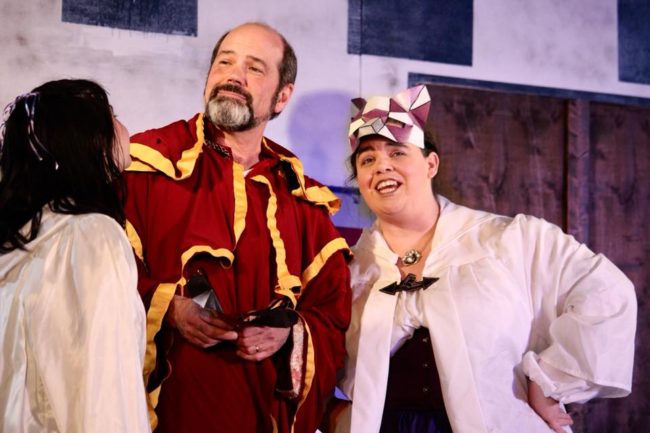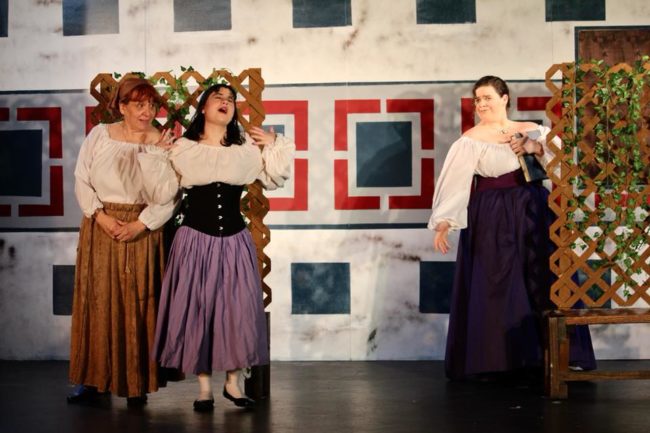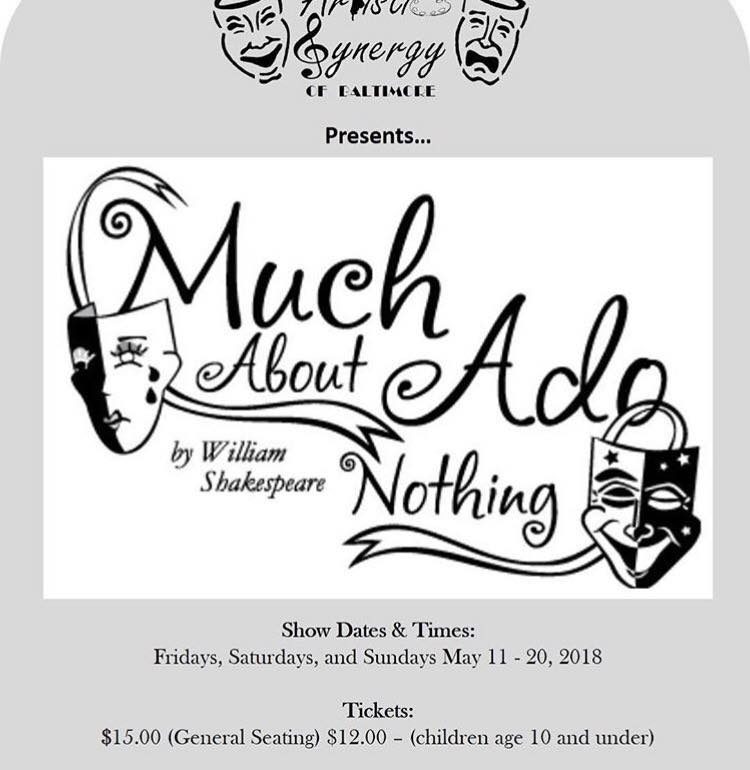Artistic Synergy of Baltimore (ASoB) presents a splendid rendition of Much Ado About Nothing, one of Shakespeare’s most well-known classic comedies. Most are probably familiar with the material already through literature class, seeing it performed elsewhere, or from the various movie versions (most notably the 1993 version directed by Kenneth Branagh), but for those who are not familiar, it can be summed up briefly as two love stories intertwining with misdirection, plotting, and comedy abound. Luckily, the plot is comparatively easy to wrap one’s head around, unlike some other Shakespeare material in which you need to pay rapt attention in order to absorb.

Without spoiling too much, the story kicks off with Don Pedro, who recently scored a victory in a small war against his own brother, Don John (who begrudgingly joins him) making a visit to Leonato, the Governor of Messina. Among Pedro’s followers are Claudio, a young officer who falls hopelessly in love with Leonato’s daughter Hero, and Benedick, another officer in Pedro’s retinue, who eventually falls in love with Beatrice (Hero’s cousin). The plot unfolds around these two love stories: Benedick and Beatrice begin at odds, teasing and insulting each other, until others trick them both separately into believing the other is in love with them, while Claudio and Hero have a much more straightforward attraction until the defeated Don John decides to meddle in their affair. A supporting cast of characters help to move push the story along, lending much comedy along the way. It ultimately has a happy ending (unlike some other Shakespeare pieces…), but definitely has some serious moments to offset the light-heartedness.
Director Lou Otero does a fantastic job of presenting the material in a very accessible and easy-to-follow fashion. For many, Shakespeare can be a hurdle to overcome as an audience member, most especially if one is not already familiar with the material. The language, obviously, is the biggest challenge – both for the audience and the cast. It might be English, but if you aren’t paying attention, can be like listening to another language entirely. Otero makes many well-decided cuts to the material and keeps the show moving at a fast and efficient clip, keeping any scene work or dialogue that does not directly lend itself to the plot from dragging down the performance and losing the audience. I imagine it can be a daunting task to edit the work of the master, but Otero quite obviously spent a lot of time ensuring he did it the right way. He commands evocative performances from every actor, and utilizes every inch of the small stage at ASoB masterfully. The audience never loses track of the action or dialogue, and the physical comedy is on point.
The set, designed by Pat White, is bare with the exception of the back wall, which looks like the outside of an old Spanish villa, but also blends appropriately for any indoor scenes. A window on the back wall displays some pivotal action points in the plot (pay attention when it’s open!), and the set is dressed minimally but very efficiently with various pieces depending on the scene. There are many blackouts and scene changes, but they move quickly and never become distracting (shout out to Stage Manager Jenn Otero for making this work!). The technical aspects are otherwise minimal, as you would expect from a play, but are well executed. Lighting Design by Daniel DeJong is always mood-appropriate, with mainly a white/yellow wash for the majority of the show. The hues shift when the mood becomes dark or angry, and brighten when the mood is more jovial. Bill Bisbee (who also plays Leonato) makes good use of stage mics to ensure the cast can always be heard. Amy Bell’s costuming has the entire cast looking period-appropriate and convincing. The origami-like masks that are used in the ball scene toward the beginning of the show are a really nice touch.

As for the performances, the cast as whole has varying degrees of aptitude for The Bard’s material (which is to be expected, we can’t all be Patrick Stewarts!), but always put forth an invested 100%. Their diction is on point, making the language easier to grasp, and their pacing never lets the dialogue sit too long or move too quickly to be understood. The emoting and physical performance of each and every actor on stage is always representative of the context, which does leaps and bounds for audience comprehension.
Among the supporting cast, Jim Morgan handles the two characters he plays with great physical comedy (The Messenger and Verges the watchman). His palsy-filled wide-eyed dementia as Verges is always funny, although the thick cockney accent sometimes gets in the way of diction. Jim Driver could not look more appropriate for the two smaller parts he plays (Seacole the watchman and the Friar), and looks like he is having a great time on stage.
The princely brothers, Don Pedro (Jim Fitzpatrick) and Don John (Andrew Wilkin) both do a bang-up job with their characters and clearly understand their nuances. Fitzpatrick plays the kind yet over-confident (and not a little chauvinistic) Don Pedro with ease, almost reminding me of one of the haughty Princes from Into the Woods. Wilkin plays the dark, mysterious, and angry Don John to the hilt with a hint of Bond villainy. He understands the language well and utilizes it to his advantage in pulling off the begrudging nature of the character. Without a good villain, a significant portion of the story would fall flat, and Wilkin is up to the task. Bill Bisbee gives a commendable performance as Leonato, the Governor or Messina, especially in the second act and during the garden scene. Ron Zyna, as Leonato’s older brother Antonio, gets an intense moment in the spotlight when facing off against the Prince in the second act.
Greg Bell knocks his performance of the oafish constable Dogberry out of the park. His mannerisms, inflections, and commanding, booming baritone all work in perfect harmony to bring the character’s traits full circle. The way he proudly eats up the insults thrown his way by Leonato and others, clearly not understanding their meaning, is one of the comedic highlights of the show. His energy on stage is palpable and always draws the full attention of the audience. Dogberry may loudly and proudly proclaim that he is an ass, but Bell’s performance shows us otherwise!

In the more traditional love match of the show, Jake Schwartz and Joan M. Firestein play Claudio and Hero respectively. They are fairy tale adorable when they are together, and Jake Schwartz has an almost surprising intensity and nuance to Claudio. When he first arrives on the scene, he comes across as cute, gullible, and childish (his giggles are also infectious), but once things turn sour at the hand of Don John, he flips a switch and turns on a passion that takes over the stage. Schwartz has a rare ability to under-play his hand while drawing full attention at the same time. He displays the character’s bravado, remorse, and internal conflicts easily, while managing to get in the laughs where he can. Firestein plays the archetype of the doting maiden and bruised lover deftly, and plays off her counterpart in Schwartz quite well.
Ringing in with standout performances are the other two lovers of the show, Benedick and Beatrice, played by Tom Piccin and Liz Armour respectively. Armour’s portrayal of the brash earnestness and playful nature of Beatrice are always on full display, and she commands every word of the Shakespearean language. Powerful, full of life and brimming with energy, she meets the Shakespearean expertise of Piccin head-on. Piccin’s Benedick is hands-down the highlight of the show, and it is very clear that he is no stranger to The Bard. He has an innate ability to make the slippery language conversational and 100% accessible to the audience. His emoting, voice affectations, and gesticulations welcome the audience with open arms, and he is able to garner laughs in even the most unexpected of places. His cadence and pacing are flawless, and he commands every scene he is in, all the while knowing exactly when to blend into the background and let the others have their moment in the spotlight. Both are performances not to be missed.
With Otero’s apt cuts and fast pacing, the show runs 1 hour and 45 minutes including one fifteen-minute intermission, making this a fun-filled experience for both Shakespeare newbies and veterans. Do yourself a favor and make your evening Much Ado About Shakespeare with Artistic Synergy of Baltimore!
Running Time: 1 hour and 45 minutes with one intermission
Much Ado About Nothing plays through May 20, 2018 at Artistic Synergy in the basement of the Prince of Peace Lutheran Church— 8212 Philadelphia Road in Rosedale, MD. Tickets can be purchased by calling the box office at (410) 833-5181 or by purchasing them online.

